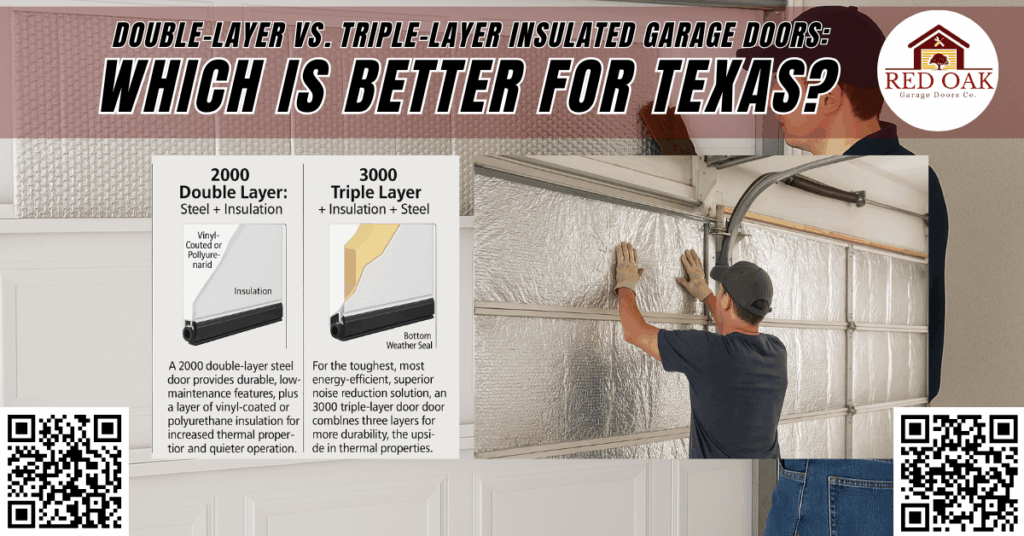If you’ve ever stepped into your garage on a blazing summer afternoon in Dallas, you know it can feel like walking into a furnace. Just last month, we helped a homeowner in Lake Highlands who was dealing with unbearable garage heat, cracked paint on their car garage door, and skyrocketing energy bills. After switching from a non-insulated door to triple-layer insulated garage doors with polyurethane core, they reported not only a cooler garage space but also lower monthly cooling costs.
Did you know that garages can account for up to 30% of a home’s total energy loss if not properly insulated? In Texas, where summer temperatures often exceed 100°F, this translates to higher electricity bills and added stress on your HVAC system. Choosing the right insulated garage door isn’t just about comfort, it’s about energy efficiency, home protection, and long-term savings.
Whether you’re building a new garage, replacing an old door, or upgrading to reduce energy loss, understanding the difference between double-layer and triple-layer insulated garage doors is essential. Let’s explore the key differences, pros and cons, insulation materials, and how to decide which is best for your Texas home or commercial property.
What Are Insulated Garage Doors?
Insulated garage doors are crafted to regulate temperature and enhance energy efficiency using multiple layers of materials. These door types typically feature insulation material such as polystyrene, polyurethane, or rigid foam, sandwiched between steel or aluminum panels. Some models even include fiberglass reinforcements or batt insulation options.
The primary goal is to create a barrier against thermal transfer, keeping heat out during the summer and warmth in during the winter. Whether you opt for clopay garage doors, amarr garage doors, or martin garage doors, the insulation layer plays a vital role in the door’s overall performance.
For homes with attached garages, an insulated garage door can greatly reduce the transfer of heat into interior spaces, improving overall home energy efficiency. For detached garages or commercial units, these doors still provide major benefits like noise reduction, weather resistance, and added durability.
Double-Layer Insulated Garage Doors
What Are They?
Double-layer insulated garage doors feature two main layers: a sturdy steel or aluminum outer skin and a layer of polystyrene foam insulation bonded to the interior. Some may have a vinyl backing to cover the insulation material and provide a cleaner appearance.
This configuration offers moderate insulation and durability, making it a step up from non-insulated doors or single-layer steel doors. It’s a popular option for homeowners looking to upgrade without incurring a high initial cost.
Benefits of Double-Layer Garage Doors
- Energy Efficiency: Double-layer doors help regulate temperature, improving energy savings compared to single-layer doors.
- Lower Initial Cost: Great for homeowners looking to improve insulation without a major investment.
- Lightweight Material: Easier on the garage door opener and easier to install.
- Basic Noise Reduction: Reduces street noise and operational sound compared to thin, uninsulated doors.
Best Applications
- Detached garages
- Properties in areas with mild weather fluctuations
- Homeowners on a budget
- Garages not used for living or workspace
Drawbacks
- Lower R-Value (usually R-4 to R-7)
- Less structural strength than triple-layer models
- Less effective at insulating the garage space during extreme Texas heat
- Shorter lifespan compared to thicker, insulated models
Triple-Layer Insulated Garage Doors
What Are They?
Triple-layer insulated garage doors consist of:
- A steel or aluminum outer layer
- A thick insulation core, often polyurethane foam, for its superior R-value
- A steel or aluminum inner backing panel that seals and protects the insulation
These are the most durable, energy-efficient, and secure garage doors available in today’s market. They often include features like urethane-coated surfaces, advanced seals, and heavy-duty hardware.
Benefits of Triple-Layer Garage Doors
- Maximum Energy Efficiency: With R-values up to 18 or higher, they minimize energy loss, lower energy bills, and improve temperature stability.
- Noise Reduction: Triple-layer doors provide exceptional noise control, ideal for homes near highways or busy neighborhoods.
- Durability: Resistant to dents, warping, and extreme weather conditions, these doors are built to last.
- Protection: Better protection for items stored in your garage, from tools and electronics to car batteries.
- Enhanced Curb Appeal: Custom design options match craftsman garage doors and modern home styles.
Best Applications
- Attached garages
- Garages used as workshops, gyms, or additional living space
- Areas with extreme weather (hot summers or winter cold snaps)
- Homeowners seeking long-term return on investment
Drawbacks
- Higher initial cost
- The heavier structure may require a more powerful garage door opener
- Longer installation time and potentially higher labor cost
The Texas Weather Factor: Why Insulation Matters
Living in Texas means enduring some of the hottest and most unpredictable weather in the country. In summer, your garage temperature can soar past 120°F. Without insulation, the heat quickly transfers through thin garage doors, turning your garage space into a sauna.
In the winter, while temperatures aren’t as extreme, sudden cold fronts can still cause thermal shock to your vehicles, tools, or stored belongings. Choosing an insulated garage door acts as a shield against weather extremes, helping to preserve both comfort and property value.
Insulated doors also help reduce humidity and condensation, which can lead to rust, mold, and mechanical wear over time. In areas of Dallas prone to hail or high winds, doors with thick insulation and reinforced panels provide added durability.
Understanding R-Value and U-Value
R-Value: Insulation Power
The R-value indicates a door’s resistance to heat flow. The higher the R-value, the better the insulation.
- Double-layer doors: R-4 to R-7
- Triple-layer doors: R-9 to R-18+
U-Value: Thermal Transfer Efficiency
The U-value measures the rate of heat transfer. Lower U-values indicate better insulation performance. An energy-efficient insulated door should aim for a low U-value and high R-value, especially for attached garages.
Choosing the right insulation type, such as polyurethane (dense and high R-value) or polystyrene (rigid but lower R-value), plays a key role in long-term comfort and energy savings.
Soundproofing, Strength, and Durability
Garage doors often serve as the largest moving wall in your home, and choosing a durable, sound-resistant model can go a long way in improving your daily experience. Triple-layer garage doors, with their additional insulation and thicker panels, excel at blocking external noise from traffic, construction, or neighborhood activity.
Moreover, these doors offer better impact resistance, reducing maintenance costs from dents or warping. Reinforced materials such as fiberglass, steel, and urethane coatings ensure longer life spans and fewer repairs. Triple-layer models also reduce stress on the garage door opener by evenly distributing weight and minimizing resistance.
Choosing Between Double-Layer and Triple-Layer Garage Doors
| Feature | Double-Layer Doors | Triple-Layer Doors |
| Insulation Type | Polystyrene | Polyurethane |
| R-Value Range | R-4 to R-7 | R-9 to R-18+ |
| Energy Efficiency | Moderate | High |
| Noise Reduction | Basic | Excellent |
| Durability | Good | Excellent |
| Cost | Affordable | Higher Initial Investment |
| Weight | Lighter | Heavier |
| Applications | Detached garages, basic upgrades | Attached garages, multi-use spaces |
How Can Red Oak Garage Doors Co. Help You?
At Red Oak Garage Doors Co., we understand that every home and garage is different. Whether you’re looking to save on energy bills, protect your garage space, or simply upgrade your curb appeal with a new garage door, we offer tailored solutions for every budget and need.
Our experienced technicians are trained in installing all types of insulated garage doors, including top-tier triple-layer polyurethane models and durable double-layer foam doors. We use trusted brands like Clopay, Amarr, Martin, and Chamberlain garage doors, and we offer:
- Free on-site assessments and measurements
- Step-by-step guide to product selection
- Custom designs to match your home
- Fast, reliable installation and service
- Garage door opener upgrades and logic board checks
We serve homeowners and businesses throughout Dallas, TX, and surrounding areas with pride, integrity, and dedication to quality.
📍 Visit us at: 901 East 5th Street, Dallas, TX
📞 Call today for a free consultation: (469) 564-0070
Red Oak Garage Doors Co. Where Comfort Meets Craftsmanship.
Protect your investment, enhance your home, and beat the Texas heat with an insulated garage door built to last.
Frequently Asked Questions
1. How long do insulated garage doors typically last?
Insulated garage doors can last 20–30 years with proper maintenance, especially triple-layer models made with durable steel and polyurethane cores.
2. Can I upgrade my existing garage door to add insulation?
Yes, insulation kits using rigid foam, batt insulation, or reflective materials can be added to most existing garage doors, though results won’t match factory-sealed insulated doors.
3. Do insulated garage doors increase home value?
Yes, installing an insulated garage door can improve curb appeal and energy efficiency, which are both attractive features for potential buyers.
4. Are there smart garage door openers compatible with insulated doors?
Absolutely—insulated garage doors work seamlessly with smart openers like Chamberlain or LiftMaster, including those with Wi-Fi, backup batteries, and logic boards.

